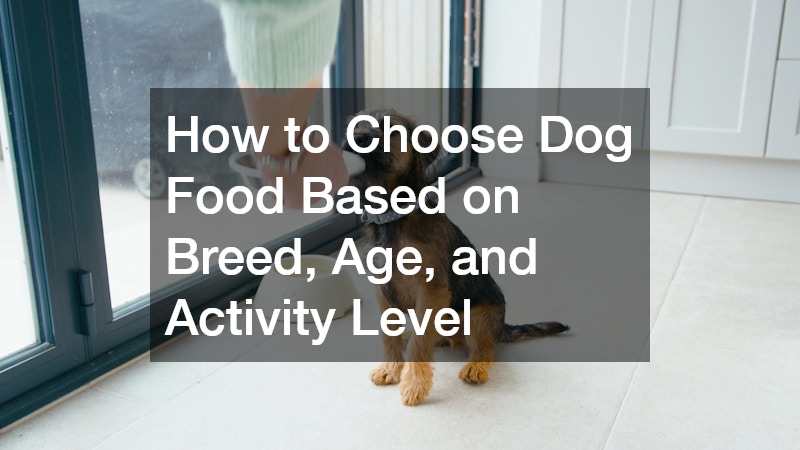
Understanding the importance of selecting the right dog food is crucial for maintaining your furry friend’s health and happiness. By considering factors such as breed, age, and activity level, you can tailor your choice to meet your dog’s nutritional needs effectively. Selecting a dog food that aligns with these factors not only supports physical health but also contributes to your dog’s overall well-being.
Nutritional Needs of Different Dog Breeds
Small Breeds
Small dog breeds often have higher metabolic rates than their larger counterparts, meaning they burn calories more quickly. As a result, they require dog foods that are rich in high-density nutrients to meet their energetic needs. It’s also important to note that smaller kibble sizes aid in proper digestion and nutrient absorption for these pint-sized pups.
Their unique dietary needs stem from their compact size, which demands nutrient-rich meals to sustain their energy levels throughout the day. Foods rich in protein and fat are especially beneficial, as they provide the necessary energy for these active little dogs. Additionally, small breeds benefit from diets that include omega fatty acids, promoting healthy skin and a shiny coat.
Large Breeds
Large breed dogs have different caloric and nutritional requirements due to their larger bodies and unique growth patterns. They are prone to joint and bone issues like hip dysplasia, making balanced nutrition crucial for healthy growth. Opt for dog foods that specifically cater to large breeds, often containing a balance of calcium and phosphorus to support bone health.
High-quality large-breed formulas typically include glucosamine and chondroitin to protect joint health and maintain mobility. These ingredients are essential because large breeds put more stress on their joints due to their size. Feeding a large breed a diet too rich in calories can lead to obesity, exacerbating pressure on joints and bones.
Protein-rich diets that include lean meats such as chicken or fish are ideal for maintaining muscle mass while also being rich in essential amino acids. Additionally, large breed dogs benefit from high-fiber content in their diets to aid digestion and prevent bloating. Tailoring your dog’s food according to its size ensures adequate nutrition that supports healthy development and activity.
How a Dog’s Age Impacts Their Dietary Needs
Puppy Nutrition
Puppies experience rapid growth and development, requiring a diet rich in essential nutrients to support their early life stages. Protein is crucial for building strong muscles, while DHA, an omega-3 fatty acid, supports brain and vision development. It’s also important that puppy food contains the right balance of vitamins and minerals to enhance growth.
During this phase, puppies need food that is higher in calories compared to adult dogs to fuel their boundless energy and active playtime. Calcium and phosphorus are critical for developing sturdy bones and teeth, ensuring strong structural development. Choosing a puppy formula with small kibble size can also help ease the transition from mother’s milk to solid food.
Feeding puppies with a well-balanced diet sets the stage for their lifelong health and behavior. Establishing a consistent feeding routine helps regulate their digestion and energy levels throughout the day. It’s vital to switch to age-appropriate formulas as they transition through different life stages to maintain optimal health.
Senior Dog Nutrition
As dogs enter their senior years, their dietary needs shift significantly to accommodate age-related changes. Senior dogs often experience a decrease in metabolism and activity levels, necessitating adjustments to their food’s caloric content. Lower calorie intake helps prevent weight gain, which can strain aging joints and lead to additional health issues.
Many senior dog foods are designed to support joint health through the inclusion of glucosamine and omega fatty acids, helping improve flexibility and reduce discomfort from arthritis. Antioxidants are also critical in senior diets, enhancing immune system function and helping combat age-related conditions. Ensuring that these elements are present in their diet is key to maintaining their quality of life.
What Role Does Activity Level Play in Choosing Dog Food?
Feeding a High-Energy Dog
High-energy dogs, such as working breeds and active pets, require a diet that supports their vitality and sustained exertion. These dogs benefit immensely from diets rich in proteins and fats, providing the energy necessary for their rigorous activities. It’s essential to select dog food that meets their increased caloric needs to prevent weight loss and maintain muscle mass.
High-energy dogs often display greater endurance and stamina, necessitating a steady supply of nutrients to fuel their pursuits. Carbohydrates, such as those from whole grains and vegetables, offer a quick energy source to keep them active and engaged. Optimal food choices should also include amino acids to support muscle recovery after intense exercise.
Feeding a Low-Energy Dog
Low-energy dogs, often characterized by their calm disposition or sedentary lifestyle, have different nutritional needs. Their diet should be carefully monitored to avoid excess calorie intake, which can lead to obesity and accompanying health issues. A low-fat diet with adequate protein helps maintain muscle mass while preventing unnecessary weight gain.
Dietary fiber plays a vital part in a low-energy dog’s diet, promoting feelings of fullness without adding extra calories. It aids digestion and helps regulate bowel movements, ensuring overall health. Weight management formulas often include L-carnitine, which helps convert fat to energy and supports healthy weight levels.
Choosing the right dog food involves considering various factors like breed, age, and activity level. A well-informed choice will provide your dog with balanced nutrition and promote a long, healthy life. By customizing your pet’s diet to its specific needs, you help ensure its health, happiness, and vitality.

